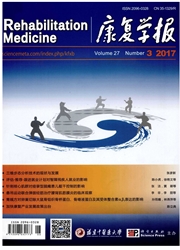

 中文摘要:
中文摘要:
背景:前期研究发现,电针可通过影响骨性关节炎软骨细胞JAK-STAT信号通路,并有效增加转化生长因子β1含量及促进关节软骨中STAT3、Smad3、Lep R mR NA的表达以延缓关节软骨退变,同时电针后血清能有效抑制凋亡调控基因p38、Fas m RNA,并降低MAPK信号通路的表达,从而抑制软骨细胞凋亡。目的:从Ras-Raf-MEK1/2-ERK1/2信号通路探讨电针对骨关节炎大鼠软骨退变的影响。方法:选取2月龄健康雄性SD大鼠120只,随机抽取30只为正常组,其余90只大鼠用4%木瓜蛋白酶法进行双侧关节腔注射造模后再用抽签法随机分为3组,即造模组30只、电针15 min组30只、电针30 min组30只。于造模后2周开始给予电针治疗,电针15 min组与电针30 min组均为5次/周,连续干预12周后,苏木精-伊红染色观察软骨形态,ELISA检测滑膜组织中白细胞介素1β表达,Western Blot检测Ras、Raf、MEK1/2、ERK1/2、C-MYC、C-FOS、C-JUN蛋白含量表达。结果与结论:(1)经苏木精-伊红染色,模型组关节软骨表面局部粗糙不平,软骨层变薄,4层结构缺失,且潮线不完整,电针15 min组和电针30 min组的软骨表层基本完整,软骨层次清晰可辨,潮线相对完整;(2)ELISA结果显示,模型组白细胞介素1β表达含量明显高于正常组(P〈0.01),电针15 min组与电针30 min组的白细胞介素1β含量表达均低于模型组(P〈0.01);(3)Western Blot结果显示,与正常组比较,模型组的Ras、Raf、MEK1/2、ERK1/2、C-MYC、C-FOS、C-JUN均表达升高。与模型组比较,电针15 min组与电针30 min组的Ras、Raf、MEK1/2、C-MYC、C-FOS、C-JUN蛋白含量表达显著降低(P〈0.01,P〈0.05),同时亦降低ERK1/2表达;(4)结果提示,电针可通过调控Ras-Raf-MEK1/2-ERK1/2信号通路的相关指标,下调关节软骨Ras、Raf、MEK1/2、ERK1/2、C-MYC、C-FOS、C-JUN蛋白表达,并降低滑膜组织中白细胞介素1β含量表达,从而延缓骨关节炎软骨退变。
 英文摘要:
英文摘要:
BACKGROUND: Previous studies have found that electroacupuncture can delay articular cartilage degeneration mediated by JAK-STAT signaling pathway through upregulating the expression level of transforming growth factor 131 as well as mRNA expression levels of STAT3, Smad3 and LepR. In the meanwhile, electroacupuncture can inhibit the mRNA expression of p38 and Fas mRNA mediated by MAPK signaling pathways, further inhibiting the apoptosis of chondrocytes. OBJECTIVE: To explore the effect of electroacupuncture on the degeneration of articular cartilage in rats with knee osteoarthritis based on Ras-Raf-MEK1/2-ERK1/2 signaling pathway. METHODS: 120 male healthy Sprague-Dawley rats aged 2 months olds were selected and randomly divided into normal model, 15-minite electroacupuncture and 3g-minute electroacupuncture groups (n=30 par group). The rats in the latter three groups received the intra-articular injection of 4% papain bilaterally, and the remaining rats received no intervention At 2 weeks after modeling, the latter two groups were respectively given 15- and 30-minute electroacupuncture, five times weekly for consecutive 12 weeks. The morphology of the cartilage was observed by hematoxylin-eosin staining, the expression level of interleukin-1β in the synovium was detected by ELISA assay, and the protein expression levels of Ras, Raf, MEKI/2, ERKI/2, C-MYC, C-FOS, and C-JUN were detected by western blot analysis. RESULTS AND CONCLUSION: Hematoxylin-eosin staining showed that: in the model group, the cartilage surface was rough, the cartilage layer became thinner, and the cartilage structure was damaged with incomplete tidal line; in the 15- and 30-minute electroacupuncture groups, the cartilage structure was complete with clear layers and complete tidal line. ELIGA showed that the expression level of interleukin-1β, in the model group was significantly higher than that in the normal group (P 〈 0.01), and the level in the 15- and 30-minute electroacupuncture groups was significantly lower than
 同期刊论文项目
同期刊论文项目
 同项目期刊论文
同项目期刊论文
 期刊信息
期刊信息
